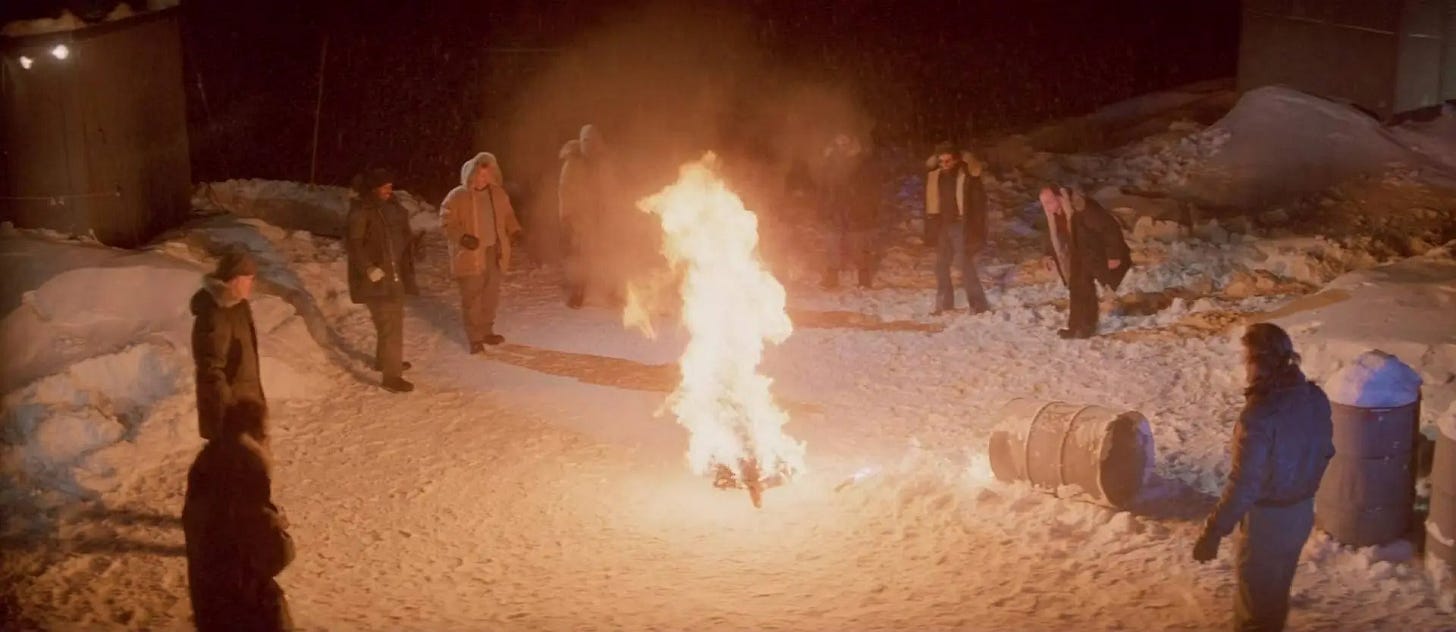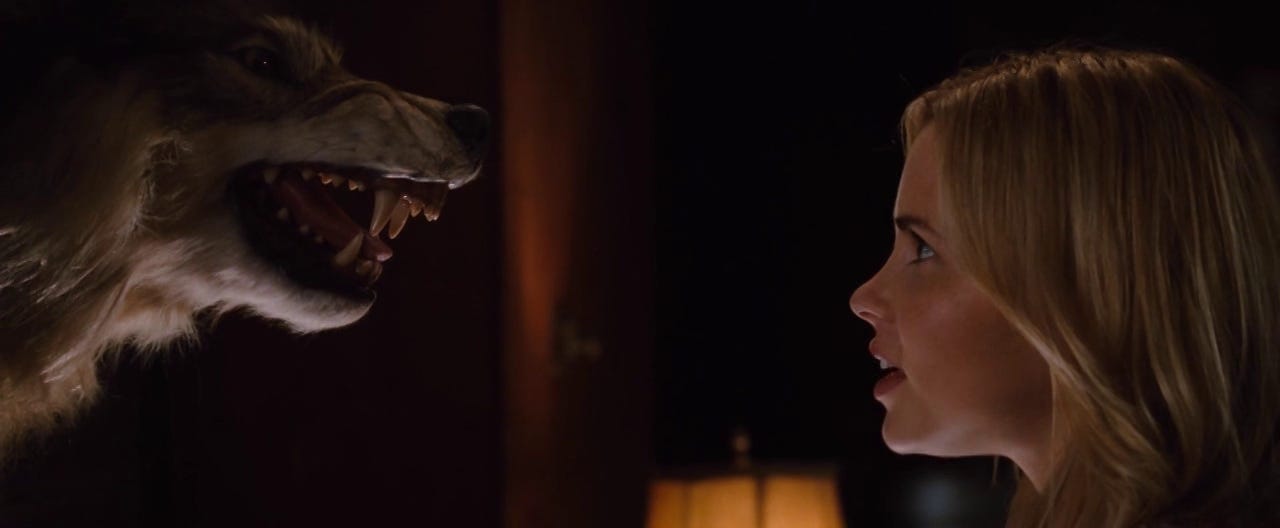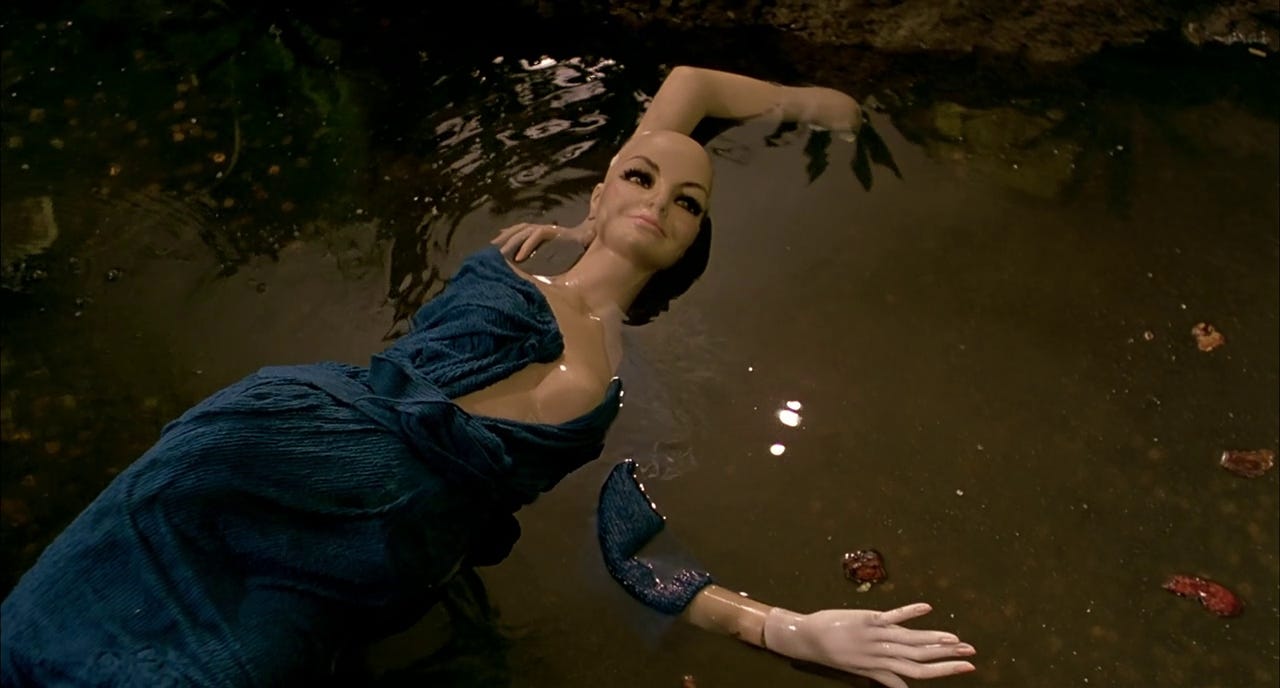Well, it’s October. And as such, I’ve been watching a lot of horror lately. Something I’ve realized is that every horror movie is about capitalism, or about surviving it.
Filmmakers can use our fears—whether psychological or embodied—to make poignant observations about the landscape of consumption, or simply to satirize it (like Dawn of the Dead). Capitalism is also one of the most horrifying things human beings have collectively conceived, so any exploration of the underbelly of our existence via the emotions of fear & terror will eventually knock on capitalism’s door.
It’s quite simple to appear as one thing while actually being another thing, and that’s another part of how horror films evoke those emotions in us: the endless suspicion—or haunting confirmation—that what you see is not how it appears. This is even more horrifying when what you see looks like something or someone that was once familiar, but is actually a grotesque imitation.
As humans, it is natural to want to see ourselves reflected in the world around us. The “uncanny valley” is horrifying because it consists of things that are halfway-human, or not-quite-human, or used-to-be-human. It’s an approximation of a human, and that is deeply unsettling. This is the same mechanism which makes capitalism work so well, especially as a modern-day memetic machine: it takes many shapes, always working to imitate your humanity and thus disarm you against it.
The problem is, capitalism has become so talented at this type of imitation that we are now less and less likely to notice the uncanny valley when we are traversing it. It becomes more and more difficult to distinguish the human from the manufactured, and it pulls at the threads of our collective & individual identities.
For some, a total loss of identity is seen as a marker of enlightenment. For most of us, living in bodies with egos, the loss of identity is destabilizing and sometimes terrifying. On a larger scale, widespread losses of identity—through the erosion of culture, displacement from land, and ruptured histories—can unfasten a society and leave people vulnerable to isolation, nihilism, and the breakdown of the social contract.
When it actually arrives, capitalism brings with it a massive desacralization of culture. It is a system which is no longer governed by any transcendent Law; on the contrary, it dismantles all such codes…
This makes capitalism very much like the Thing in John Carpenter’s film of the same name: a monstrous, infinitely plastic entity, capable of metabolizing and absorbing anything with which it comes into contact.
Mark Fisher, Capitalist Realism (note: this is a PDF download link)
I watched The Thing for the first time recently, and sensed the connection even before opening Fisher’s book. Capitalism is a lot like the Thing; that comparison isn’t a stretch. Both lack a stable constitution and survive by consuming and imitating whatever they touch. You cannot be alone with the Thing, or it will wrap its tendrils around you, drain your life, and assume your likeness. What remains is a moving copy with no center. Life in late capitalism, paired with a surveillance state, begins to look like this too: an endurance loop of consumption in which we are fed versions of ourselves in order to keep feeding the machine.
The comparison works not only because both devour and impersonate, but because they produce a culture of suspicion. In the film, the possibility that anyone could be The Thing corrodes trust among the men, and four decades later, that paranoia now reads as a preface to the widespread loneliness that defines late capitalism. The system profits when we distrust one another, because distrust keeps us fragmented and predictable.
It completely destroys any concept of individuality that these characters have[…] Even more unsettling is the complete lack of explanation of the thing’s motives. There’s no reasoning with it because it never talks, except when imitating somebody it has already absorbed. It’s an utterly ruthless animal that understandably leaves the men questioning their own identities.
Mark Harrison
Capitalism is always attempting to reflect you back to yourself. It does this by collecting what you do—what you buy, click, watch, search, post—and assembling that information into a picture of “who you are.” Then, it shows you that picture on repeat: the same kinds of products, the same kinds of ads, the same kinds of posts and people. Often, the repetition works. The image of you constructed for consumption starts to feel true simply because it’s what you see most. You begin to recognize that picture as “me,” even when it’s only a slice of who you are.
Late-stage capitalism tightens the vice by tying consumption to identity. You’re encouraged to signal who you are by what you acquire and display. Buying isn’t just about having a thing; it’s also about enrolling in a category—runner, corporate raver, eco-conscious parent, alt-fashion artist, what have you—and digital platforms translate those purchases into social proof. The more your consumption fits into the lane, the more said lane is reinforced.
By trying to control that reflection, capitalism is also trying to control how you identify. If the mirror mostly reflects certain categories or demographics back to you, you’re nudged to live inside them because the mirror rewards compliance with things like more recommendations, easier discovery, smoother checkout, and perhaps most importantly, a sense of belonging. In the same gesture, capitalism is able to de-legitimize and devalue what doesn’t “convert”. Parts of you that aren’t legible to the market—grief, ambivalence, illegibility, weirdness, disability, refusal—get less visibility and less reinforcement, which makes them harder to sustain in public. This also is the sun cult in action.
Once identity is formatted as data, it can be sorted, priced, and advertised to. Advertisers bid more for “high-value” identities and less for others. Platforms test what we’ll respond to and then optimize toward that response. It’s an endless, memetic feedback loop: the system shows us a version of ourselves, we act inside that version, the action produces more data, and the data locks the version in more tightly.
That is the function of capitalism’s imitation. You don’t have to force anyone to be a certain person so they will consume a certain product; you just keep feeding them a usable version of themselves until it feels natural—and profitable—and they’ll buy almost anything to reinforce that version, because it seems like the most authentic. That’s what is particularly sickening about the ever-morphing body of capitalism: it doesn’t mind reflecting your own anti-capitalist or anti-consumerist values back at you, either, so long as it results in an identity-affirming purchasing pattern.
Generative AI has intensified this process at an alarming rate, and has also ramped up the enclosure of the commons. By laminating vast archives of human expression into convincing replicas, it simulates familiarity, but also becomes its own kind of uncanny valley. The machine doesn’t need to know you; it only needs to pass well enough to keep you engaged and consuming, constantly reaffirming your categorizable identities.
Consumerism empowers capitalist subjects by granting them a limited, but politically important space in which to live out utopian fantasies of autonomy.
Stephen Harper
Another horror film, The Cabin in the Woods exposes the sacrificial contract that underwrites all of this. In this film, the primary horror reveals itself to be a ritual of appeasement for ancient forces that demand human sacrifice. The translation to capitalism here is not subtle: the system requires ongoing offerings of labor, attention, bodies, land, and resources in exchange for a sense of order, while threatening devastation if the ritual stops. We’ve been keeping those gods asleep for a long time.
The point isn’t to ask whether capitalism imitates us “for” something else. It’s not harvesting bodies on behalf of anyone or anything but itself. The imitation is the point, just like the Thing. This is a horror trope that shows up in the most deeply unsettling characters: the villain who causes chaos and destruction with no discernible outside motives; they are purely motivated by the chaos & destruction they serve.
Oftentimes, the way these villains are defeated is through some sort of collective effort that renders their attempts to sow chaos ineffective and thus disarms them. Think of the citizens on the boats in The Dark Knight who are told by the Joker that both of the vessels will explode if one group doesn’t decide to pull the pin and make the other boat explode first. Both sides refuse to pull their pins and sacrifice the other boat, and neither boat ends up exploding.
It may sound silly or paradoxical, but sometimes the best way to disarm something that is threatening everything you know & love is to start living as if it’s no longer an issue. I’m not talking about sticking your head in the sand, never paying another bill, or turning a blind eye to suffering, but rather about acting as if capitalism isn’t inevitable and you are already living in a world without it.
This is what I mean: how would you relate differently to others, even your closest loved ones, if you woke up tomorrow and capitalism was gone? How would your values change? What would you spend your time and money on? Not to sound like a manifestation girlie, but you better start showing up as that version of yourself as much as you possibly can. Capitalism instills capitalist values in every person; how can you start examining & dismantling those values right now?
Capitalist realism can only be threatened if it is shown to be in some way inconsistent or untenable; if, that is to say, capitalism’s ostensible ‘realism’ turns out to be nothing of the sort.
Mark Fisher, Capitalist Realism
In other words: show where capitalism fails to account for life and death and relation and humanity, and the spell is broken.
Horror, like capitalist realism, also gives us visceral lessons about inevitability. In The Thing, death is not a twist ending; it is in the air everyone breathes. Characters start making choices as if the end has already been written—which, of course, ensures their collective demise. At the end of the film, the two remaining characters may be alive and not infected by the Thing, but it doesn’t matter at that point, because all hope is lost and all trust is destroyed. The men cannot recognize each other as allies, for fear of getting too close to a monster that looks just like an ally.
That posture (moving as if the outcome is fixed) mirrors what Fisher calls reflexive impotence: we believe nothing can be done, so we don’t try; because we don’t try, nothing is done; because nothing is done, we take it as proof that nothing can be done. The machine loves this loop. It keeps us compliant and exhausted.
I don’t want to just sit here and lament how well the machine works. I want to interrupt the paradigm that says there’s no other script. Death is inevitable; capitalism’s choreography of life and death is not. Horror teaches two truths: the monster wins sometimes, and also, there are moments where a character refuses the script long enough for somebody else to get free. That’s the nut we have to pry open while adjusting our expectations away from pristine post-capitalist utopias.
You can refuse capitalist realism and disavow capitalism’s inevitability by treating collapse as a medium, not a death sentence. Train for a world that is already uneven and already breaking apart. Plan in terms of what can be salvaged rather than what can be perfected. Trade the fantasy of total solutions for a rhythm of cascading, localized wins that accumulate into a culture.
Every horror movie is about capitalism, but especially Dawn of the Dead. It may have the most heavy-handed satirical metaphors, enclosing both the victims and the monsters within the enclosed, fishbowl-type environment of a shopping mall. Romero frames the mall as an afterlife, where even the undead drift back to shop because consumption has created a reflex so deep it outlives them. The camera lingers on escalators and window displays while the undead repeat a dance learned in life. This is Romero’s version of capitalist realism: the most imaginable thing to do at the end of the world is shop.
Repetition & enclosure, inside a sealed world such as a shopping mall, starts to dissolve time—the very fabric of life. There is no more separation between day or night, under the 24-hour fluorescent glow of retail lighting. The changing of the seasons is not marked by weather or leaves, but by rotating sales and display swaps. That feeling that there is no “outside” is the heart of capitalist realism, and it echoes in Romero’s shopping mall. It’s learned, staged, manufactured, reinforced, and it can be unlearned.
We can also learn a lot about disarming capitalist realism through the choices made by characters in horror films. In The Thing, the viewer witnesses how suspicion and distrust shrink an environment to the point where nobody can make a move without garnering hostility; inevitability manifests in the form of mutually assured destruction. It’s easy enough to say “we just need to learn how to trust each other!” but the real point of The Thing could just as easily be about recognizing your enemy for what they are, and banding together against them. The ruling class of billionaires currently cannibalizing the planet definitely do not want us recognizing them for what they are and banding together against them; they benefit much more from our deep suspicion of our neighbor’s motives.
Similarly, the takeaway from The Cabin in the Woods could be “give up and sacrifice yourself to the monsters, because you’re too powerless to take them down,” which would suit capitalist realism just fine. However, I have a feeling the subversion here is more along the lines of: a world which is held together by the slaughter of innocents is not a world that needs to exist at all.
The point I’m making here isn’t toward nihilism, but toward the acceptance that the generative, post-capitalist world we co-create will be one that rises from the ruins of this world.
As Anna Tsing puts it in The Mushroom At The End of The World, “Neither tales of progress nor of ruin tell us how to think about collaborative survival.” There is no transition that doesn’t involve some destruction, but avoiding that destruction leads to a complete immobilization and suspension of all expressions of life—human and non-human alike.
What this future will require is cross-species collaboration, and also the willingness of human beings to de-center their species. From here, the lens on horror shifts a little for me: can you trust the source, given that capitalism’s partnership with moving pictures has the ability to shape and reshape how humans view ourselves?
What capitalism does most effectively is conscript the collective imagination. Film is a powerful accomplice: it can build and unbuild entire identities at scale, and it can do so while convincing us we’re only being entertained. That’s the danger inside capitalist realism.
Every horror film is about capitalism, unless it’s there to make you forget about capitalism—but even then, it’s still about capitalism. Perhaps it’s true that horror, especially the most extremely violent or symbolism-laden films, is a way for humans to imagine horrors even worse than capitalism, to make themselves feel temporarily relieved about their day-to-day horrors. That’s a tin foil hat I’d gladly wear.
But I know I’m not alone in the fact that I’ve been way less able to stomach a lot of fictional horror these days, because the live-streamed horrors are so accessible and in abundance. What am I really trying to escape from here, if I have to watch actors pretend to be brutally murdered in order to temporarily forget about the real-life people who are being brutally murdered on my phone? What is the net outcome of that?
This isn’t a condemnation of the horror genre; let me be clear about that. This is an account of just one more thing capitalism has rotted from within, and I’m particularly bitter about it because it’s an art form I have a great deal of respect for.
The answer isn’t to pretend film is neutral or to purify your viewing habits. It’s to become more human than the imitation. Horror can help with that. For some people, feeling fear in a contained setting restores the capacity to feel at all. It also reminds the body that terror is an emotion that serves a purpose. However, a line you must carefully watch: there’s a difference between increasing your tolerance for fear and sanding down your response to suffering. You’ll know the difference by your instinct to pull in and become less human in response, or to breathe out and become infinitely more human.
Thank you for reading!
Your ongoing support makes it possible to continue writing, podcasting, & offering more sliding scale and no-cost offerings in the future. To become a Cosmic Co-Op member, click here.
If you’d like a paid subscription, but can’t afford it, please reach out to me and I’ll add you, no questions asked.
Share this publication: like, comment, reply to this email, or link me on your social media! I love to receive thoughtful feedback and continue conversations beyond this platform--especially in our community Discord server.





